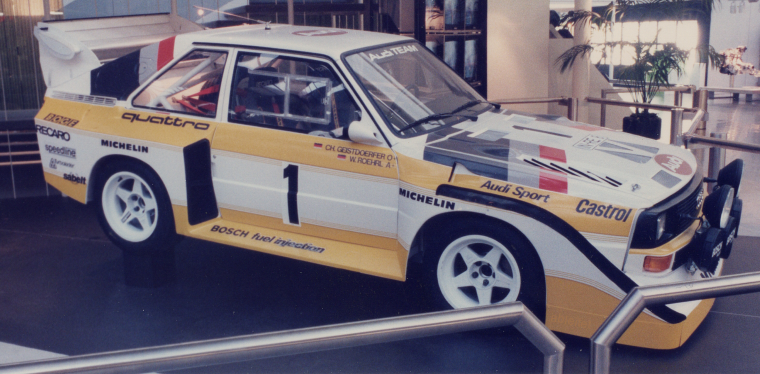Audi Sport Quattro S1 (Gr.B)

Last of its kind – the final rallye Quattro
Not all of the drivers were pleased by the shortened Sport Quattro as a successor to the Quattro A2, especially Walter Röhrl. In many situations the predecessor did better than the new car, so Audi had to evolve the rallye Sport Quattro. This resulted in the winged Audi Sport Quattro S1. The big setup of wings in front and rear meant better traction. A lot of auxiliary parts where moved around in the chassis to improve weight distribution to a 52:48 balance ratio.
For many rallye fans, the Sport Quattro S1 is one of the most popular, historic rallye cars overall, much thanks to it’s iconic noise. Considering amongst Group B car, this manifested itself as the L’OHEAC S1 auctioned at a staggering € 1 725 000 in early 2021.
First used in Argentina 1985, and having its last WRC round 1986 in Portugal, these cars present the wildest version of the rallye Quattros. Chassis-wise the Sport Quattro S1 are identified independently from the Sport Quattro series. Only 20 cars were built, whereas the last car was used in regular S1 costume in 1986 at the Pikes Peak event (see below), before seeing a change for the more extreme version in 1987 at the same event.
Engine: inline 5, alu-block, alu-head, 20V.
Capacity: 2110cc by bore 79,5 mm x 85 mm stroke
Compression-ratio: 7:1
Power: 476hp / 7500 rpms
Torque: 480Nm / 5500 rpms
These engines do 8500 rpms, and features 2.2 BAR from their K29/K27 turbos. Different drivetrains were tested, but mainly matched to a 6-speed gearbox with hydraulic operated clutch. The center differential setup were more closely related to the later urquattro TorSen-setup, but were interchangeable depending on conditions. As an oddity, a few S1s experimented with a semiautomatic gearbox. This was sourced off the Porsche 952, known as the Porsche Doppel Kupplung (PDK). Basic design resembles today’s DSGs, which tended to throw the co-driver off pace.
Top speed at approx 220 km/h and 0-100 km/h is done in 3.1 seconds.
Length/height/width 4240/1860/1343 mm.

The race to the clouds – Pikes Peak hillclimb
After the cancellation of Group B in 1986, Audi searched for another primary arena to display it’s rallye Quattro cars. The Pikes Peak hill-climb in Colorado was their next step.
Michele Mouton raced to victory in 1984 & 1985 in a rallye Sport Quattro, so it seemed only natural to let loose the S1. In 1986 Audi put Bobby Unser junior in S1 no. 20. Walter Röhrl followed in 1987, setting a new record at 10:47.85.
The basis of the car was still the very same Sport Quattro S1, but it featured more aerodynamic tweaks in the shape of additional spoilers and an air duct on the roofing. This was supporting the final setup of an S1 engine, benched to 598 hp/590 Nm.

Is it named Sport Quattro S1, S1 E2, S1E2 or S1 Evo 2 ?
I am aware a lot will familiarize with this as the mentioned S1 Evo 2, S1 E2 or S1E2 – this page is about that very same car. See how John Davenport describes it here.
Doing my work, I want to comply with (the understanding) this is the actual way Audi named their car to begin with. The usage of Evo seems to be a rather FIA influenced convention. Even of late 2019, it is seen that Audi Tradition themselves are now using ‘Sport Quattro S1’.
Audi Tradition on Instagram, 24th of September 2019:

Following the milestone of rallying Quattros, the successor in the Audi 200 rallye was not by far as noticeable in the sport of rallying…